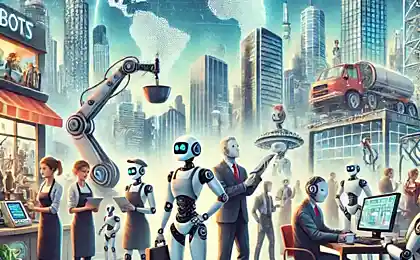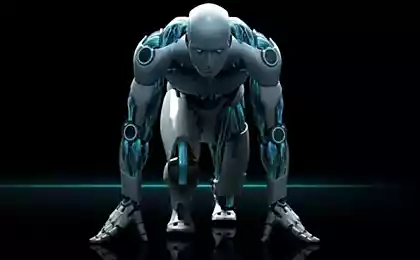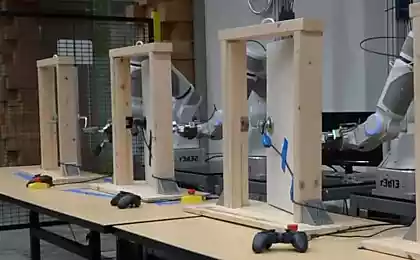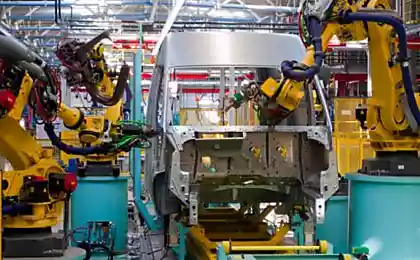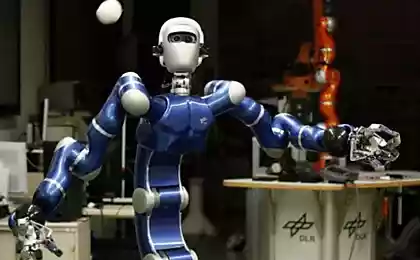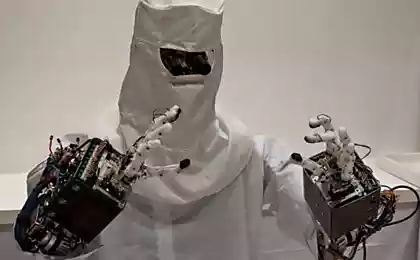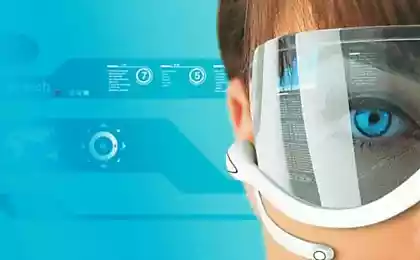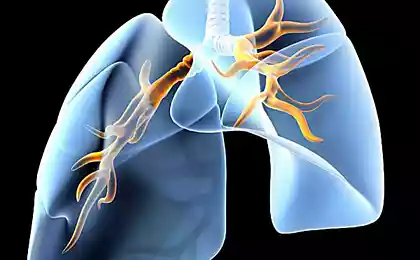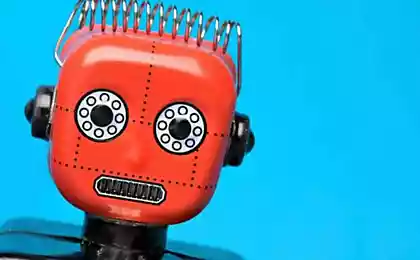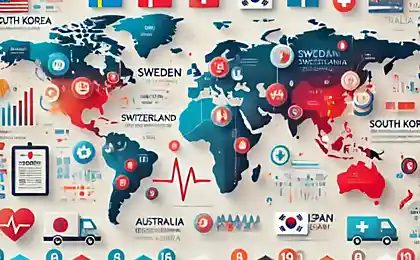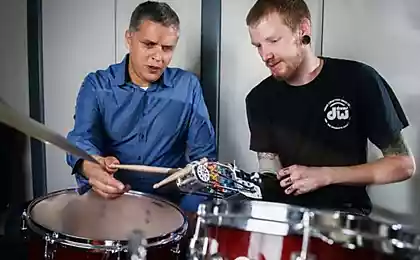496
Cure all 7 main trends in innovative medicine
Sixty four million seventeen thousand six hundred twenty one
© Adam Voorhes
Cyberplaza and foot-bots, the ability to edit DNA, the four-handed surgeon and the device in the programming mood or correcting posture — all legends of modern high-tech medicine. Working with them can not only be a pioneer and affect the fate of humanity, but also to ensure a carefree old age (unless, of course, in the near future will appear the elixir of youth, which is quite possible). Robotic prostheses
Cybernetic prosthetic arms, legs and eyes today are no longer seen as a product exclusively for people affected by injury or illness. The defense Ministry, major laboratories and venture capital funds often invest in the development of devices is not only useful for rehabilitation, but also can improve the skills of healthy people.
The most striking example in this sphere is, perhaps, Hugh Herr, an engineer and a scientist, Professor at the Massachusetts Institute of technology. His robotic prostheses foot Power Foot imitate the movements of these limbs so precisely that they allow the performer ballroom dance Adrianna Haslet-Davis, who lost his left leg in a terrorist attack during the Boston marathon in 2013, to return to the profession. Himself Hugh Herr lost both legs above the knee due to an accident during a mountain-climbing accident 30 years ago. Today, robotic prostheses Herr developed in the MIT Media Lab. With him on the creation of cyberdog employs 23 people (including graduates of the Massachusetts Institute of technology), and 26 students are studying there under the guidance of Professor.
Another interesting initiative is PossessedHand — in fact, is not a prosthesis. This device is worn on the arm and stimulate the muscles according to a preset program. The device is designed for people whose limbs were not lost, but has lost the ability to move. But those who are healthy, PossessedHand can also be useful: thanks to the cybernetic arm you can learn to play the violin or juggling. The device is made by laboratory Lab Rekimoto, who works in the University of Tokyo.
The authors of the project to create an artificial retina-the Argus, which today is also called cybernetic eye, receive funding from the U.S. Department of energy. Their device is already sold in America and some EU countries. The kit includes goggles with camera, transmitter, and tiny electrodes that are implanted in the tissue back of the eye. Through them, the transmitter is essentially just translates the image from the camera. And if initially the number of electrodes was very small and the picture quality suffered: only 16 elements, or pixels, then today their number has reached several hundred, that allows patients who were once blind to read large letters.
Ustroistvom wearable devices — one of the main modern technological trends. They are developed for the treatment and prevention of various diseases and also for sports and support a healthy lifestyle. Often the wearable device mounted on the wrist, but there are devices that need to be worn on other parts of the body. One of the latest developments — miniature Thync device that communicates with a smartphone and allows the owner to control their mood with the push of a button. At Thync has tiny electrodes that are connected to the skin on the head. Depending on the selected range of dates their impact causes a feeling of cheerfulness, as if you drank extra energy or helps to relax for 45 minutes — after a good massage.
The Thync produces a company founded in 2011 by a group of scientists-neuroscientists from Harvard, Stanford, MIT and other universities. The principle of operation of this device is called "transcranial micropolarization". In the USA it is permitted by Management under the control over products and medicines and used in the framework of physiotherapy. Transcranial micropolarization allows you to temporarily change the status of the various regions of the CNS with small DC. Thync has allowed its creators to attract venture capital in the amount of about $ 13 million. The main investor was Khosla Ventures. Deliveries will begin in 2015. The headquarters of the company is located in Silicon valley, and an additional office in Boston.
Another wearable device — a wireless sensor LumoBack — has already become one of the textbook examples of successful health initiatives from scratch. This device is designed for people who suffer from back pain and have to constantly monitor the posture. Lumo must be worn at the waist. If the person starts to slouch, he feels a soft vibration so the sensor reminds you that you need to straighten the back. Via Bluetooth Lumo constantly sends information to your smartphone, which analyzes how many calories you spend per day, how much time they spent sitting and standing and how long sports. The device costs $ 150 and is suitable for iOS and Android. Today the office LumoBack is also located in the cradle of the adventures — Palo Alto. At the stage of development of this American startup has received investments in the amount of $ 1.1 million, and then eight days of "get" on Kickstarter 170 thousand dollars instead of a hundred.
Edit Anxitey CRISPR/Cas9, or "Krisper," another legend of the modern innovative medicine. It allows you to organize genetic "expedition" to any element of the DNA of a living cell or system of cells in vitro and inside the body (including the body-human primates) and adjusting the genetic code.
In the nature system "Krisper" is found in bacteria and is analogous to the mechanism of acquired immunity, which is in animals and people. When a bacterium encounters a virus, it copies its DNA and sends a "sketch" in gene repository, which is called СRISPR. If the microbe will encounter the virus again, he "knows" it through the copy and create the RNA probe, is able to recognize genes and to contact them to prevent infection. However, by itself, such a probe for the virus harmless, and here it comes in the protein Cas9. It represents "scissors", capable of destroying the viral genes. Grabs Cas9 RNA probe and, as if on a leash comes after him to the DNA of the virus. When the probe is in place, a protein receives a signal to cut here! At the same time the number of "cuts" there are no restrictions: dissecting the genome can be at least a thousand points.
In the next 10-20 years "Krisper" can help physicians to cope with serious illnesses: for example, to learn how to fully remove from the body of an adult defective parts of genes that cause cancer, and activate the poorly performing gene for insulin in some diabetics or edit the segment of DNA responsible for obesity, if it is transmitted hereditary. Experiments on primates already are. In January 2014, were born the first monkey, which introduced mutations in two genes: one is associated with the immune system and the other regulating the deposition of fat.
The team is headed by Professor Emmanuelle Charpentier who committed one of the major discoveries in the field of gene editing using the "Krisper". Venture funds promised $ 25 million for commercialization of discoveries. A former colleague of Charpentier and one by the discoverer of the possibilities of the system, Professor Jennifer Doudna from UC Berkeley joined its rivals. She was offered venture capital in the amount of 43 million dollars for the invention of a method to apply "Krisper" in clinical practice.
Smartphone diagnostics and cloud servicesonline smartphones has paved the way for many new endeavors, including in the control condition. Today there are many apps that calculate how much you drank water, how long been up and how many extra calories picked up for lunch. One of the most promising initiatives is the app Ginger.io. It allows you to monitor the day mode and may itself contact the clinic or family doctor, if something goes wrong, as usual. Using simple questionnaires Ginger.io analyzes the behavior and lifestyle of the user. It is able to determine stress and depression, prevent insomnia and God knows what else. Its creators, the app has allowed to attract investments from the five largest venture capital funds.
Another successful medical mobile app called HealthTap allows you to get medical consultations online. Patients are ready to consult the 64 thousand specialists from different countries, and this state is constantly updated. Doctors respond to users in a text format, in a social network or forum, and for a small fee, you can communicate with your doctor via private messaging. In addition, the app allows you to choose a specialist and make an appointment for a consultation. Today, HealthTap is funded by 24 of the investor. Listed and Vinod Khosla is founder of Khosla Ventures, which also supports Ginger.io.
Cloud service for geneticists DNAnexus in recent years from a small risky undertakings turned into a large company with a large staff. Among its investors — Google Ventures, TPG Biotech, Claremont Creek Ventures. The service offers tools for data analysis of relevant studies, including DNA sequencing (determining the sequence in the chain) and has been developed chromatin (to assess the regulation of transcription of genes). DNAnexus also allows you to visualize the results of DNA tests.
Medical roboticide creating surgical robots remained in the realm of theory until 1999, when the company Intuitive Surgical presented to the public the first device Da Vinci. This system allows surgeons to perform operations remotely, using the exact device associated with the workplace of the doctor on the satellite connection. Da Vinci consists of two blocks: the four-armed machine that performs the role of the surgeon in the operating room and console with 3D screen and joysticks designed for the doctor. It weighs a ton and is commercially available today. Da Vinci installed in clinics around the world, including in Russia: in Moscow, St.-Petersburg, Khanty-Mansiysk, Yekaterinburg and other cities. The robot allows to conduct operations on the heart, spine, lungs, kidneys, bladder, stomach and other organs. The device took the company Intuitive Surgical in the market leader: today it is the only supplier of apparatus of this class, teaches the surgeons and works with dozens of countries.
3D printing organosilicate prosthetic human organs is another important trend in innovative medicine. 3D printer, which uses quality material not plastic, and their own cells the person simply removes the question of the ethics of using embryonic material and allows the patient to receive the organ without waiting for a donor.
Bio-printer costing 200 thousand dollars was jointly developed by the medical company Organovo (San Diego, USA) and the engineering firm Invetech (Melbourne, Australia). It takes up very little space and placed in a sterile Cabinet. The device works on the same principle as conventional 3D printers. Thanks to the given program it causes droplets of material on the Foundation tier for tier, so the result is a three-dimensional "printing". Only instead of the polymer of the bio-printer living cells required: stem, taken from bone marrow, human liver cells, muscle, connective tissue, and others. After applying they start to "fuse" with each other, so that the result is viable biological material that is not rejected and does not cause allergies. The substrate uses the hydrogel in a sugar base, which does not interact with cells and does not stick to it: after printing, it can be easily extracted from the biological conduit. The creators of the technology say that by referring to "printed" organs are not similar to the real thing, but for patients it does not matter: after the liver or kidney from the bio-printer is still working as it should. Transplant first printed in biological 3D-printer of the bladder was carried out in 2006, and people who have received such bodies, have successfully continued to live with them.
Preventive medizinproduktegesetz of life in developed countries is increasing, and the population is aging: every year elderly people is increasing. To reduce private and public health care expenditures, are now being developed preventive medical techniques that allow to identify predisposition to disease and to build computer forecasts of their development.
American Institute for preventive medicine offers about 150 products for disease prevention. Here is the questionnaire, which identifies risks of health online, and the results are formulated in the form of a graph, the program to improve lifestyle, sleep, stress control and the like. Several researchers from the US and other countries today are also developing drugs that can slow the aging of tissues and prevent the development of diseases. American biologist bill Andrews is working on a drug based on telomerase that allows you to postpone the genetic off the process of cell division in humans and animals. Every year the bill will require millions of dollars to support the work of his laboratory, but the methods of financing are always. And his colleague from the UK, Aubrey de grey recently founded the Foundation and SENS research center located in Silicon valley. The main objective of the D. gray — creating affordable technology that will help to restore the body to any degree of youth and maintain it in this state indefinitely.
Source: theoryandpractice.ru
© Adam Voorhes
Cyberplaza and foot-bots, the ability to edit DNA, the four-handed surgeon and the device in the programming mood or correcting posture — all legends of modern high-tech medicine. Working with them can not only be a pioneer and affect the fate of humanity, but also to ensure a carefree old age (unless, of course, in the near future will appear the elixir of youth, which is quite possible). Robotic prostheses
Cybernetic prosthetic arms, legs and eyes today are no longer seen as a product exclusively for people affected by injury or illness. The defense Ministry, major laboratories and venture capital funds often invest in the development of devices is not only useful for rehabilitation, but also can improve the skills of healthy people.
The most striking example in this sphere is, perhaps, Hugh Herr, an engineer and a scientist, Professor at the Massachusetts Institute of technology. His robotic prostheses foot Power Foot imitate the movements of these limbs so precisely that they allow the performer ballroom dance Adrianna Haslet-Davis, who lost his left leg in a terrorist attack during the Boston marathon in 2013, to return to the profession. Himself Hugh Herr lost both legs above the knee due to an accident during a mountain-climbing accident 30 years ago. Today, robotic prostheses Herr developed in the MIT Media Lab. With him on the creation of cyberdog employs 23 people (including graduates of the Massachusetts Institute of technology), and 26 students are studying there under the guidance of Professor.
Another interesting initiative is PossessedHand — in fact, is not a prosthesis. This device is worn on the arm and stimulate the muscles according to a preset program. The device is designed for people whose limbs were not lost, but has lost the ability to move. But those who are healthy, PossessedHand can also be useful: thanks to the cybernetic arm you can learn to play the violin or juggling. The device is made by laboratory Lab Rekimoto, who works in the University of Tokyo.
The authors of the project to create an artificial retina-the Argus, which today is also called cybernetic eye, receive funding from the U.S. Department of energy. Their device is already sold in America and some EU countries. The kit includes goggles with camera, transmitter, and tiny electrodes that are implanted in the tissue back of the eye. Through them, the transmitter is essentially just translates the image from the camera. And if initially the number of electrodes was very small and the picture quality suffered: only 16 elements, or pixels, then today their number has reached several hundred, that allows patients who were once blind to read large letters.
Ustroistvom wearable devices — one of the main modern technological trends. They are developed for the treatment and prevention of various diseases and also for sports and support a healthy lifestyle. Often the wearable device mounted on the wrist, but there are devices that need to be worn on other parts of the body. One of the latest developments — miniature Thync device that communicates with a smartphone and allows the owner to control their mood with the push of a button. At Thync has tiny electrodes that are connected to the skin on the head. Depending on the selected range of dates their impact causes a feeling of cheerfulness, as if you drank extra energy or helps to relax for 45 minutes — after a good massage.
The Thync produces a company founded in 2011 by a group of scientists-neuroscientists from Harvard, Stanford, MIT and other universities. The principle of operation of this device is called "transcranial micropolarization". In the USA it is permitted by Management under the control over products and medicines and used in the framework of physiotherapy. Transcranial micropolarization allows you to temporarily change the status of the various regions of the CNS with small DC. Thync has allowed its creators to attract venture capital in the amount of about $ 13 million. The main investor was Khosla Ventures. Deliveries will begin in 2015. The headquarters of the company is located in Silicon valley, and an additional office in Boston.
Another wearable device — a wireless sensor LumoBack — has already become one of the textbook examples of successful health initiatives from scratch. This device is designed for people who suffer from back pain and have to constantly monitor the posture. Lumo must be worn at the waist. If the person starts to slouch, he feels a soft vibration so the sensor reminds you that you need to straighten the back. Via Bluetooth Lumo constantly sends information to your smartphone, which analyzes how many calories you spend per day, how much time they spent sitting and standing and how long sports. The device costs $ 150 and is suitable for iOS and Android. Today the office LumoBack is also located in the cradle of the adventures — Palo Alto. At the stage of development of this American startup has received investments in the amount of $ 1.1 million, and then eight days of "get" on Kickstarter 170 thousand dollars instead of a hundred.
Edit Anxitey CRISPR/Cas9, or "Krisper," another legend of the modern innovative medicine. It allows you to organize genetic "expedition" to any element of the DNA of a living cell or system of cells in vitro and inside the body (including the body-human primates) and adjusting the genetic code.
In the nature system "Krisper" is found in bacteria and is analogous to the mechanism of acquired immunity, which is in animals and people. When a bacterium encounters a virus, it copies its DNA and sends a "sketch" in gene repository, which is called СRISPR. If the microbe will encounter the virus again, he "knows" it through the copy and create the RNA probe, is able to recognize genes and to contact them to prevent infection. However, by itself, such a probe for the virus harmless, and here it comes in the protein Cas9. It represents "scissors", capable of destroying the viral genes. Grabs Cas9 RNA probe and, as if on a leash comes after him to the DNA of the virus. When the probe is in place, a protein receives a signal to cut here! At the same time the number of "cuts" there are no restrictions: dissecting the genome can be at least a thousand points.
In the next 10-20 years "Krisper" can help physicians to cope with serious illnesses: for example, to learn how to fully remove from the body of an adult defective parts of genes that cause cancer, and activate the poorly performing gene for insulin in some diabetics or edit the segment of DNA responsible for obesity, if it is transmitted hereditary. Experiments on primates already are. In January 2014, were born the first monkey, which introduced mutations in two genes: one is associated with the immune system and the other regulating the deposition of fat.
The team is headed by Professor Emmanuelle Charpentier who committed one of the major discoveries in the field of gene editing using the "Krisper". Venture funds promised $ 25 million for commercialization of discoveries. A former colleague of Charpentier and one by the discoverer of the possibilities of the system, Professor Jennifer Doudna from UC Berkeley joined its rivals. She was offered venture capital in the amount of 43 million dollars for the invention of a method to apply "Krisper" in clinical practice.
Smartphone diagnostics and cloud servicesonline smartphones has paved the way for many new endeavors, including in the control condition. Today there are many apps that calculate how much you drank water, how long been up and how many extra calories picked up for lunch. One of the most promising initiatives is the app Ginger.io. It allows you to monitor the day mode and may itself contact the clinic or family doctor, if something goes wrong, as usual. Using simple questionnaires Ginger.io analyzes the behavior and lifestyle of the user. It is able to determine stress and depression, prevent insomnia and God knows what else. Its creators, the app has allowed to attract investments from the five largest venture capital funds.
Another successful medical mobile app called HealthTap allows you to get medical consultations online. Patients are ready to consult the 64 thousand specialists from different countries, and this state is constantly updated. Doctors respond to users in a text format, in a social network or forum, and for a small fee, you can communicate with your doctor via private messaging. In addition, the app allows you to choose a specialist and make an appointment for a consultation. Today, HealthTap is funded by 24 of the investor. Listed and Vinod Khosla is founder of Khosla Ventures, which also supports Ginger.io.
Cloud service for geneticists DNAnexus in recent years from a small risky undertakings turned into a large company with a large staff. Among its investors — Google Ventures, TPG Biotech, Claremont Creek Ventures. The service offers tools for data analysis of relevant studies, including DNA sequencing (determining the sequence in the chain) and has been developed chromatin (to assess the regulation of transcription of genes). DNAnexus also allows you to visualize the results of DNA tests.
Medical roboticide creating surgical robots remained in the realm of theory until 1999, when the company Intuitive Surgical presented to the public the first device Da Vinci. This system allows surgeons to perform operations remotely, using the exact device associated with the workplace of the doctor on the satellite connection. Da Vinci consists of two blocks: the four-armed machine that performs the role of the surgeon in the operating room and console with 3D screen and joysticks designed for the doctor. It weighs a ton and is commercially available today. Da Vinci installed in clinics around the world, including in Russia: in Moscow, St.-Petersburg, Khanty-Mansiysk, Yekaterinburg and other cities. The robot allows to conduct operations on the heart, spine, lungs, kidneys, bladder, stomach and other organs. The device took the company Intuitive Surgical in the market leader: today it is the only supplier of apparatus of this class, teaches the surgeons and works with dozens of countries.
3D printing organosilicate prosthetic human organs is another important trend in innovative medicine. 3D printer, which uses quality material not plastic, and their own cells the person simply removes the question of the ethics of using embryonic material and allows the patient to receive the organ without waiting for a donor.
Bio-printer costing 200 thousand dollars was jointly developed by the medical company Organovo (San Diego, USA) and the engineering firm Invetech (Melbourne, Australia). It takes up very little space and placed in a sterile Cabinet. The device works on the same principle as conventional 3D printers. Thanks to the given program it causes droplets of material on the Foundation tier for tier, so the result is a three-dimensional "printing". Only instead of the polymer of the bio-printer living cells required: stem, taken from bone marrow, human liver cells, muscle, connective tissue, and others. After applying they start to "fuse" with each other, so that the result is viable biological material that is not rejected and does not cause allergies. The substrate uses the hydrogel in a sugar base, which does not interact with cells and does not stick to it: after printing, it can be easily extracted from the biological conduit. The creators of the technology say that by referring to "printed" organs are not similar to the real thing, but for patients it does not matter: after the liver or kidney from the bio-printer is still working as it should. Transplant first printed in biological 3D-printer of the bladder was carried out in 2006, and people who have received such bodies, have successfully continued to live with them.
Preventive medizinproduktegesetz of life in developed countries is increasing, and the population is aging: every year elderly people is increasing. To reduce private and public health care expenditures, are now being developed preventive medical techniques that allow to identify predisposition to disease and to build computer forecasts of their development.
American Institute for preventive medicine offers about 150 products for disease prevention. Here is the questionnaire, which identifies risks of health online, and the results are formulated in the form of a graph, the program to improve lifestyle, sleep, stress control and the like. Several researchers from the US and other countries today are also developing drugs that can slow the aging of tissues and prevent the development of diseases. American biologist bill Andrews is working on a drug based on telomerase that allows you to postpone the genetic off the process of cell division in humans and animals. Every year the bill will require millions of dollars to support the work of his laboratory, but the methods of financing are always. And his colleague from the UK, Aubrey de grey recently founded the Foundation and SENS research center located in Silicon valley. The main objective of the D. gray — creating affordable technology that will help to restore the body to any degree of youth and maintain it in this state indefinitely.
Source: theoryandpractice.ru
A Scottish company has developed a new floating wave energy generator
Imperfection is welcome — the architect Santiago Calatrava about the paradoxes of beauty


